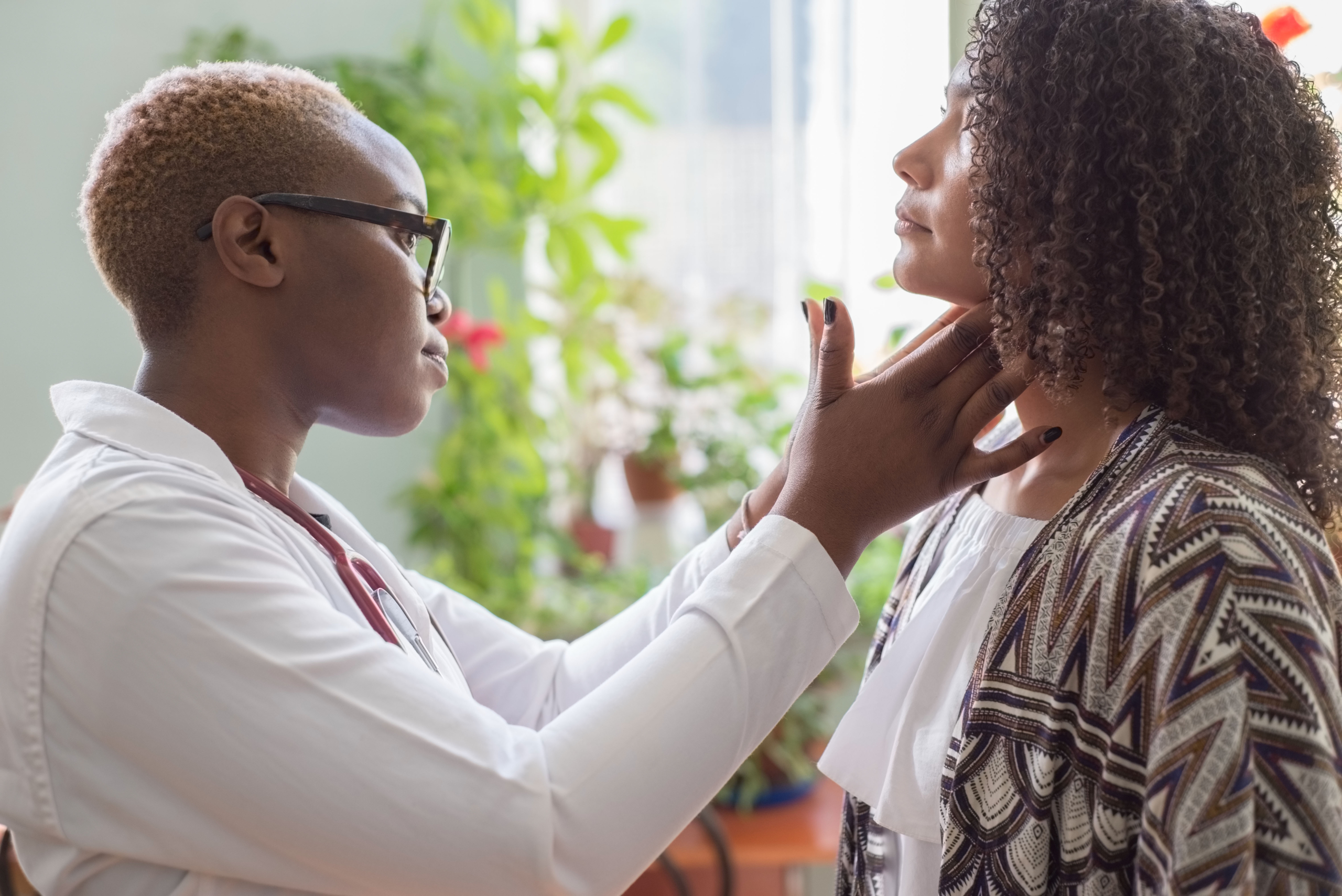What do the actor Mr. T and former professional football player Eric Berry have in common? The answer may surprise you. Unfortunately, they both were diagnosed with cancer – lymphoma, to be exact.
Lymphoma refers to a group of blood cancers that affect the body’s immune system.1 These cancers are generally not very common for Black people, and chances of survival have improved over the years.2 Nonetheless, learning about different types of lymphoma, their signs and symptoms, risk factors and current treatment options can help you stay vigilant and healthy.
What is lymphoma?
Lymphoma is a general term for cancers that start in white blood cells called lymphocytes, which help fight infections.3 Knowing which type of lymphoma you have is important because it affects your treatment options and outlook.4 The two main kinds of lymphoma are: Hodgkin lymphoma and non-Hodgkin’s lymphoma.
Hodgkin lymphoma
Hodgkin (or Hodgkin’s) lymphoma is rare compared to non-Hodgkin lymphoma and other cancers and represents 0.5% of all new cancer cases in the U.S.5 It is most often diagnosed in people in their 20s and 30s and those over 55, and people who are assigned male at birth are slightly more likely to develop Hodgkin lymphoma than those who are assigned female.6 There are two major categories of Hodgkin lymphoma: classic (or classical) Hodgkin lymphoma and nodular lymphocyte-predominant Hodgkin lymphoma.
Classic Hodgkin lymphoma is the most common type of Hodgkin lymphoma and has four subtypes7:
- Nodular sclerosis Hodgkin lymphoma: This is the most common type of Hodgkin lymphoma and occurs most often in young adults, especially women.7 It tends to start in lymph nodes (small organs that help fight infections) in the neck or chest.3,8,9
- Mixed cellularity Hodgkin lymphoma: This is the second most common type of Hodgkin lymphoma.3 It occurs most often in older adults and people with HIV infection.7 It can start in any lymph node but most often occurs in the upper half of the body.3
- Lymphocyte-rich classic Hodgkin lymphoma: This subtype of Hodgkin lymphoma isn’t common and accounts for about 6% of people diagnosed with classic Hodgkin lymphoma.7 It is more common in men and usually occurs in the upper half of the body.3,7
- Lymphocyte-depleted Hodgkin lymphoma: This is the least common type of Hodgkin lymphoma and accounts for only about 1% of people diagnosed with classic Hodgkin lymphoma.7 It occurs most often in older adults and people with HIV infection.3 It’s more aggressive than other types of Hodgkin lymphoma and likely to be advanced at diagnosis.3 It’s most often in lymph nodes in the stomach as well as in the spleen, liver, and bone marrow.3
Nodular lymphocyte-predominant Hodgkin lymphoma, which is the second major category of Hodgkin lymphoma, occurs in about 5% of people with Hodgkin lymphoma and is more common in men than women.3,7 It is most common in younger people, although it can occur in people of any age.3,7 This type of Hodgkin lymphoma usually starts in lymph nodes in the neck, armpit or groin and tends to grow more slowly compared to classic Hodgkin lymphoma.3,7
Signs and symptoms of Hodgkin lymphoma include10:
- Lump(s) in the neck, under the arm, or in the groin
- Fever (which can come and go over several weeks) without an infection
- Drenching night sweats
- Weight loss without trying (at least 10% of your body weight over 6 months)
- Itching skin
- Feeling tired (fatigue)
- Loss of appetite
- Cough, trouble breathing, chest pain
Non-Hodgkin lymphoma
Non-Hodgkin (or non-Hodgkin’s) lymphoma is one of the top 10 common cancers in the U.S. and accounts for more than 4% of all new cancer cases in the country.11 Although it can occur at any age, the risk of developing non-Hodgkin lymphoma increases with age, and it’s most common in people over 60.12 Overall, people who are assigned male at birth are more likely to develop non-Hodgkin lymphoma than those who are assigned female, but this can change depending on the type of non-Hodgkin lymphoma.13
There are many different types and subtypes of non-Hodgkin lymphoma (NHL).14 The type of lymphoma depends on what type of lymphocyte is affected: B cells, T cells, or NK cells, among other factors.15 B-cell lymphoma is the most common type of NHL.15 T-cell lymphoma is less common, and NK-cell lymphoma is rare.15
The two most common subtypes of non-Hodgkin lymphoma are diffuse large B cell lymphoma and follicular lymphoma.16
Diffuse large B cell lymphoma is the most common type of non-Hodgkin lymphoma in the U.S. and accounts for about 1 out of every 3 lymphoma cases.16 Although it can affect people at any age, it occurs most often in older people (60s and older).16 It is a fast-growing (aggressive) lymphoma that can start in different areas of the body.16 Follicular lymphoma is the next most common type of non-Hodgkin lymphoma in the U.S. and accounts for about 1 out of every 5 lymphoma cases.16 Similar to diffuse large B cell lymphoma, it occurs most often in people 60 and older and can start in different areas of the body.16 However, unlike diffuse large B cell lymphoma, it is rare in very young people and is slow-growing (indolent).16 Over time, some follicular lymphomas can turn into diffuse large B cell lymphoma.16
Signs and symptoms of non-Hodgkin lymphoma include17:
- Lump(s) under the skin
- Chills
- Weight loss without trying (at least 10% of your body weight over 6 months)
- Feeling tired (fatigue)
- Swollen stomach
- Feeling full after only a small amount of food
- Chest pain or pressure
- Shortness of breath or cough
- Severe or frequent infections
- Easy bruising or bleeding
Causes of lymphoma
The exact cause of lymphoma is unclear, but there are some diseases or factors that can increase your risk. These may include13,18-25:
- Human immunodeficiency virus (HIV)
- Human T-cell lymphotropic virus
- Epstein-Barr virus
- High levels of radiation exposure
- Family history
- Some ingredients in herbicides and pesticides
One of the risk factors of lymphoma that might be higher in the Black population is HIV. In 2019, Black people accounted for around 40% of HIV cases in the U.S.26 With lymphoma’s connection to HIV, knowing your HIV status becomes even more important.
Treatment options for lymphoma
Treatment options and recommendations for lymphoma depend on factors such as the type and stage of lymphoma, possible side effects, and the patient’s preferences and overall health. The four main treatments for lymphoma are27:
- Chemotherapy
- Immunotherapy
- Targeted therapy
- Radiation therapy
Patients can receive a combination of these treatments or may even consider surgery or bone marrow/stem cell transplantation.27
As more treatments are being developed to help patients with lymphoma, it can be helpful to consider clinical research opportunities and currently available treatment options with your doctor.
In addition to deciding on treatments to help with your physical symptoms, finding emotional support and connecting with others who may be going through similar experiences with blood disorders can also be helpful in dealing with lymphoma.
To hear stories from people of color living with blood disorders and share your story, visit: https://www.foreverstrongbynowincluded.com.
References
- Leukemia & Lymphoma Society. “About Lymphoma.” Leukemia & Lymphoma Society, 2021, https://www.lls.org/lymphoma. Accessed 20 Apr. 2023.
- Giaquinto, Angela N., et al. “Cancer Statistics for African American/Black People 2022.” CA: A Cancer Journal for Clinicians, vol. 72, no. 3, 2022, pp. 202–229., https://doi.org/10.3322/caac.21718.
- American Cancer Society. “What Is Hodgkin Disease?” American Cancer Society, 1 May 2017, https://www.cancer.org/cancer/hodgkin-lymphoma/about/what-is-hodgkin-disease.html. Accessed 20 Apr. 2023.
- American Cancer Society. “Lymphoma.” American Cancer Society, 11 Sept. 2018, https://www.cancer.org/cancer/lymphoma.html. Accessed 20 Apr. 2023.
- National Cancer Institute. “Cancer Stat Facts: Hodgkin Lymphoma.” SEER Cancer, National Cancer Institute, https://seer.cancer.gov/statfacts/html/hodg.html. Accessed 20 Apr. 2023.
- Mayo Clinic. “Hodgkin’s lymphoma (Hodgkin’s disease).” Mayo Clinic, 8 Mar. 2022, https://www.mayoclinic.org/diseases-conditions/hodgkins-lymphoma/symptoms-causes/syc-20352646. Accessed 20 Apr. 2023.
- American Society of Clinical Oncology. “Lymphoma – Hodgkin: Introduction.” Cancer.Net, American Society of Clinical Oncology, Mar. 2022, https://www.cancer.net/cancer-types/lymphoma-hodgkin/introduction. Accessed 20 Apr. 2023.
- Cleveland Clinic. “Lymph Nodes.” Cleveland Clinic: Every Life Deserves World Class Care, 31 May 2022, https://my.clevelandclinic.org/health/body/23131-lymph-nodes. Accessed 20 Apr. 2023.
- American Cancer Society. “Lymph Nodes and Cancer.” American Cancer Society, 2 Mar. 2021, https://www.cancer.org/treatment/understanding-your-diagnosis/lymph-nodes-and-cancer.html. Accessed 20 Apr. 2023.
- American Cancer Society. “Signs and Symptoms of Hodgkin Lymphoma.” American Cancer Society, 1 May 2018, https://www.cancer.org/cancer/hodgkin-lymphoma/detection-diagnosis-staging/signs-and-symptoms.html. Accessed 20 Apr. 2023.
- National Cancer Institute. “Cancer Stat Facts: Non-Hodgkin Lymphoma.” SEER Cancer, National Cancer Institute, https://seer.cancer.gov/statfacts/html/nhl.html. Accessed 20 Apr. 2023.
- Mayo Clinic. “Non-Hodgkin’s lymphoma.” Mayo Clinic, 26 Oct. 2022, https://www.mayoclinic.org/diseases-conditions/non-hodgkins-lymphoma/symptoms-causes/syc-20375680. Accessed 20 Apr. 2023.
- American Cancer Society. “Non-Hodgkin Lymphoma Risk Factors.” American Cancer Society, 19 Sept. 2022, https://www.cancer.org/cancer/non-hodgkin-lymphoma/causes-risks-prevention/risk-factors.html. Accessed 20 Apr. 2023.
- American Cancer Society. “What Is Non-Hodgkin Lymphoma?” American Cancer Society, 1 Aug. 2018, https://www.cancer.org/cancer/non-hodgkin-lymphoma/about/what-is-non-hodgkin-lymphoma.html. Accessed 20 Apr. 2023.
- American Society of Clinical Oncology. “ASCO Answers Non-Hodgkin Lymphoma.” Fact sheet. American Society of Clinical Oncology. Alexandria, VA. 2022. Web. https://www.cancer.net/sites/cancer.net/files/asco_answers_nhl.pdf. Accessed 20 Apr. 2023.
- American Cancer Society. “Types of B-cell Lymphoma.” American Cancer Society, 29 Jan. 2019, https://www.cancer.org/cancer/non-hodgkin-lymphoma/about/b-cell-lymphoma.html. Accessed 20 Apr. 2023.
- American Cancer Society. “Signs and Symptoms of Non-Hodgkin Lymphoma.” American Cancer Society, 1 Aug. 2018, https://www.cancer.org/cancer/non-hodgkin-lymphoma/detection-diagnosis-staging/signs-symptoms.html. Accessed 20 Apr. 2023.
- Berhan, Ayenew, et al. “HIV/AIDS Associated Lymphoma: Review.” Blood and Lymphatic Cancer: Targets and Therapy, Volume 12, 29 Apr. 2022, pp. 31–45., https://doi.org/10.2147/blctt.s361320.
- Nosaka, Kisato, and Masao Matsuoka. “Adult t‐Cell Leukemia‐Lymphoma as a Viral Disease: Subtypes Based on Viral Aspects.” Cancer Science, vol. 112, no. 5, 2021, pp. 1688–1694., https://doi.org/10.1111/cas.14869.
- Crombie, Jennifer L., and Ann S. LaCasce. “Epstein Barr Virus Associated B-Cell Lymphomas and Iatrogenic Lymphoproliferative Disorders.” Frontiers in Oncology, vol. 9, 2019, https://doi.org/10.3389/fonc.2019.00109.
- Satta, Giannina, et al. “Occupational Exposure to Ionizing Radiation and Risk of Lymphoma Subtypes: Results of the EPILYMPH European Case-Control Study.” Environmental Health, vol. 19, no. 1, 2020, https://doi.org/10.1186/s12940-020-00596-9.
- United Kingdom National Health Service. “Hodgkin lymphoma.” The NHS Website, United Kingdom National Health Service, 22 Nov. 2021, https://www.nhs.uk/conditions/hodgkin-lymphoma/causes/. Accessed 20 Apr. 2023.
- Cancer Research UK. “Risks and causes.” Cancer Research UK, 4 Dec. 2020, https://www.cancerresearchuk.org/about-cancer/non-hodgkin-lymphoma/risks-causes. Accessed 20 Apr. 2023.
- ‘T Mannetje, Andrea, et al. “Occupation and Risk of Non-Hodgkin Lymphoma and Its Subtypes: A Pooled Analysis from the INTERLYMPH Consortium.” Environmental Health Perspectives, vol. 124, no. 4, 4 Sept. 2015, pp. 396–405., https://doi.org/10.1289/ehp.1409294.
- Rana, Iemaan, et al. “Benzene Exposure and Non-Hodgkin Lymphoma: A Systematic Review and Meta-Analysis of Human Studies.” The Lancet Planetary Health, vol. 5, no. 9, 24 Aug. 2021, https://doi.org/10.1016/s2542-5196(21)00149-2.
- Centers for Disease Control and Prevention. “HIV and Black/African American People in the U.S.” Centers for Disease Control and Prevention, 6 July 2022, https://www.cdc.gov/nchhstp/newsroom/fact-sheets/hiv/black-african-american-factsheet.html. Accessed 20 Apr. 2023.
- American Society of Clinical Oncology. “Lymphoma – Non-Hodgkin: Types of Treatment.” Cancer.Net, American Society of Clinical Oncology, Mar. 2021, https://www.cancer.net/cancer-types/lymphoma-non-hodgkin/types-treatment. Accessed 20 Apr. 2023.



